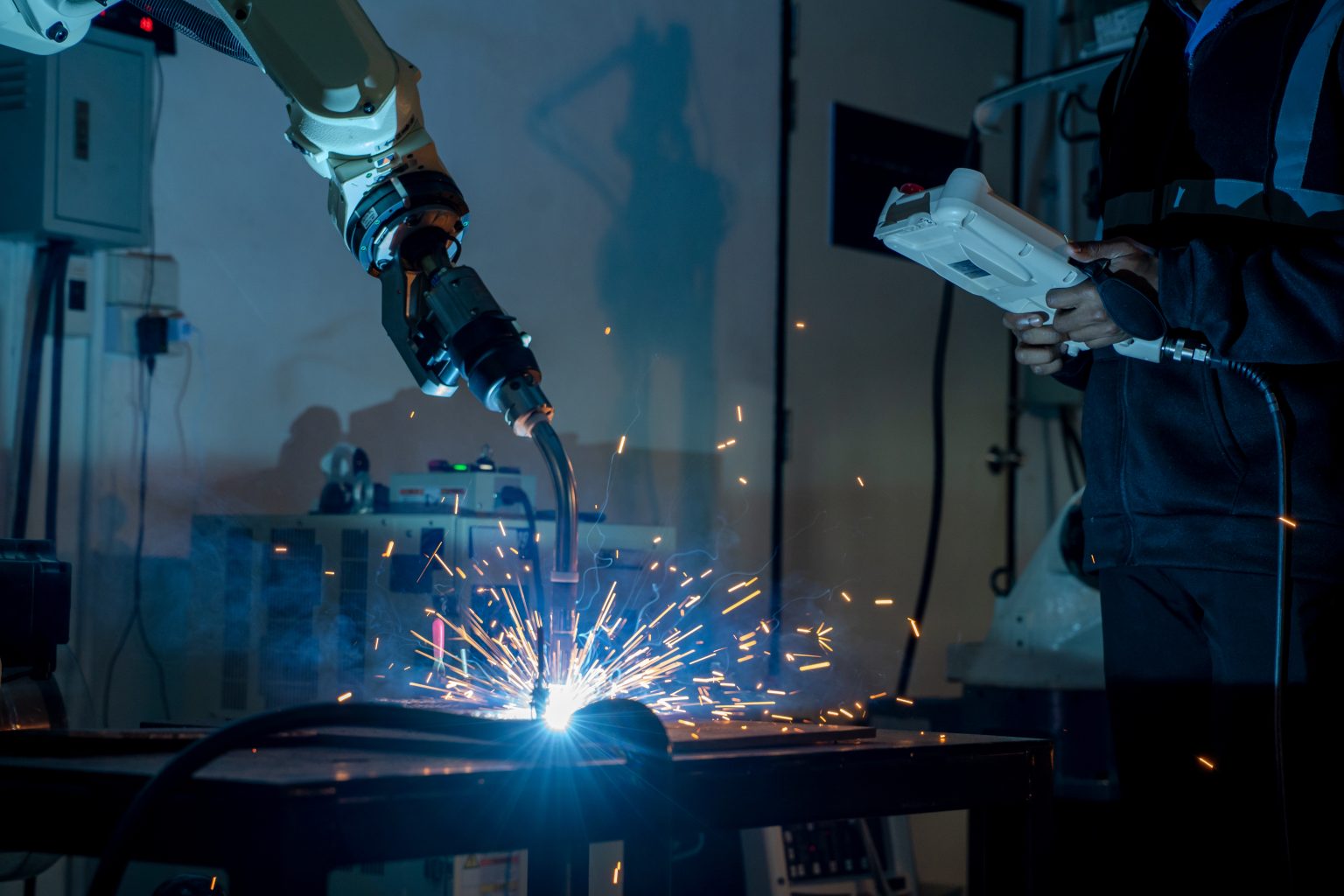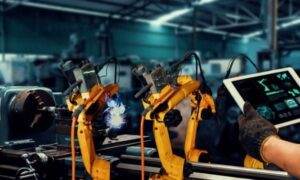What is a welding robot?
A welding robot is an automated machine built to carry out welding work with remarkable accuracy and reliability. Each unit combines hardware and software components such as articulated arms, welding torches, feedback sensors, and control processors, allowing it to handle intricate joints swiftly. Such automation boosts output, delivers uniform welds, and spares human workers from the heat and fumes of traditional welding shops. That blend of speed and safety makes welding robots essential in sectors that repeat high-volume welds, including auto assembly, aircraft production, and heavy construction.
View Welding Robot for sale – Zhouxiang for More Details
How Do Welding Robots Operate?
Welding robots carry out tasks by following a set program that specifies every motion speed, joint angle, and welding technique to apply. The articulated arm, fitted with a welding head, pivots along multiple axes until the puddle forms in the right place. To cover any slight mismatch in parts, built-in sensors or cameras can detect gaps and adjust the torch path in real time. An industrial controller oversees the entire process, and technicians feed new patterns through user-friendly programming software. All movement is driven by electric motors and pneumatic valves that work together to deliver quick, precise control.
View Welding Robot Manufacturers in China – Zhouxiang details to get into the details.
Industrial welding relies on several robot styles, each built to meet a particular job on the shop floor. The most frequently seen models include:
Articulated Robots: With several rotating arms linked together, these machines bend and twist like a human shoulder, handling complicated joints and paths.
For more in-depth information, you should view the Welding Robot – Zhouxiang.
Cartesian Robots: Moving in straight lines along X, Y, and Z tracks, they deliver the steady accuracy needed for parts that must fit together perfectly.
SCARA Robots (Selective Compliance Assembly Robot Arm): Quick and forgiving in one plane, SCARA units tackle light, repeatable welds where speed trumps reach.
Collaborative Robots (Cobots): Built-in sensors let these helpers stay close to people, offering extra hands and consistent welds without throwing safety rules out the window.
Delta Robots: Three long arms fly in a triangular pattern, finishing small assemblies at a blistering pace while missing almost no detail.
Manufacturers choose the right type based on the weld itself, volume goals, and safety codes, so every robot runs smoothly and adds value.
How does robotic welding improve productivity?
Benefits of Automating Welding
Welding automation delivers clear gains, chief among them greater accuracy, steadiness, and productivity. Because robotic arms repeat the same motion without tiring, each joint looks the same and costly mistakes tied to operator fatigue shrink noticeably. Automated machines also run around the clock, turning out parts faster than any shift-based crew, so output volumes climb. By confining people away from searing arcs, toxic fumes, and flying sparks, these systems also raise shop-floor safety.
How Robotic Welding Boosts Production Efficiency
Robotic welders cut lag by keeping work flowing and slashing the stops that plague manual lines. Their software-driven motions handle routine seams at top speed and with near-zero variance, so queues and jams all but disappear. Modern code even links robots to laser scanners, conveyors, and quality monitors, allowing real-time tweaks that keep every stage in step. The end result is shorter cycles, higher throughput, and the dependable, precise response that high-volume markets expect.
Cost-Effectiveness of Robotic Welding Systems
Over time, installing robotic welding units can generate substantial savings for manufacturers. Although the initial purchase price is steep, lower labor bills, less scrap, and fewer defects quickly recover the outlay. Robots produce cleaner seams with minimal rework, boosting quality, delighting customers, and cutting warranty costs. Their rugged design and light upkeep also yield years of service, making them a durable, money-wise answer to steady production needs.
What are the common types of welding robots?
Arc welding robots rank among the most common automated systems found on factory floors today. They are built to use a high-voltage electric arc to fuse metal parts, a technique the welding field knows well. Because of this purpose-built design, these machines deliver welds that are both exact and uniform, a feature crucial to the car, airplane, and ship industries. The robots work faster than people and repeat each motion with the same accuracy, so output rises and product quality stays stable. They handle both MIG metal-inert-gas and TIG tungsten-inert-gas processes, letting a single cell join aluminum, mild steel, or stainless steel as needed. Those benefits make arc welding robots ideal for high-volume runs, while their use also cuts down on employee tiredness and lowers the risks linked to manual spark-and-heat work.
Collaborative robots, often called cobots, are now finding a place beside arc welders as part of the next generation of welding gear. Built to share workspace with human operators, cobots trade raw speed for agility, letting factories meet a range of jobs without extensive retooling. Modern units come loaded with safety sensors, force-limiting motors, and user-friendly software that guard people while making setup simple. That flexibility makes cobots the go-to choice for high-mix, low-volume lines where product designs shift often and quick changeovers are essential.
Because the software is simple, small and medium-sized companies without deep robotics know-how can start using the machines right away. Welding cobots are now found in construction, electronics, and custom shops, doing spot, seam, and repair joints in a way that saves money and grows with orders.
Laser Welding Robots: Features and Benefits
Laser welding robots focus a fierce beam of light to fuse parts with matchstick-thin seams at remarkable speed. They shine where a narrow, deep weld and little heat spread matter, so electronics makers, medical-device builders, and makers of precision cars count on them. These units easily handle odd shapes and perform non-contact work, sparing fixtures from excessive wear. The beam’s high-energy pack also cuts cycle times; parts move through the line quicker than with older methods. Operators gain stronger joints, less cleanup, and overall tighter quality control, since many finishing touches can be skipped. By weaving laser cells into the factory flow, firms boost output and consistency, securing these robots place at the leading edge of todays welding technology.
What is the welding process used in robotic welding?
Robotic welding uses programmable machines to carry out welds with a level of accuracy and repeatability that human operators find hard to match. Each robot works with its own welding torch, onboard sensors, and custom software that defines the exact bead size, angle, and motion for every joint. Engineers first teach the robot, sometimes with a handheld pendant, at other times through offline simulation, logging key settings such as travel speed, heat input, and movement path. After the code is loaded, the articulated arm and end-of-tool attachments repeat the weld across batch after batch, delivering the same seam every time and trimming down scrap. That consistency not only lifts output rates but also keeps product quality within strict limits for manufacturers who rely on automated welding lines.
Comparing Robot Welding to Manual Welding Techniques
Robot welding usually outperforms hand welding in efficiency, consistency, and safety. Since manual quality depends on the individual welders’ training and judgment, automated cells provide nearly error-free seams even during long runs. Robots also move faster and tolerate tougher factory conditions, allowing around-the-clock production without the fatigue that slows people. By isolating humans from molten metal, intense light, and toxic smoke, automated arcs cut many workplace hazards. Yet skilled hands still lead many specialty jobs, because fine detail, sudden layout changes, or creative problem-solving can stump even the best code.
Robotic welding automation draws on multiple interlinked technologies to deliver high precision and speed to meet the demands of modern factories. Foremost among these are machine-vision cameras that track seams in real time and flag defects, so the welder applies the bead exactly where it is needed, even on parts with uneven edges. Sophisticated motion-control software choreographs the robot arms and tools, fine-tuning speed, acceleration, and path to reduce overshoot and shorten cycle times. When bolstered by artificial-intelligence routines that learn from each weld and adjust voltage, travel speed, or gas flow on the fly, the system becomes even more resilient to variation. Operators also rely on MIG, TIG, laser, or hybrid power sources that match the energy profile to the base metal, thickness, and desired finish without manual reconfiguration. Together, these pieces push robotic welding far beyond simple repeatability, opening new possibilities for cost-effective, high-quality automated production.
What are the challenges faced by manufacturers in adopting welding robots?
Manufacturers today must contend with a serious shortage of trained welders across the sector. Though welding work is growing quickly, the number of workers who have the right skills has not kept up. The resulting gap slows production schedules and pushes firms to lean more heavily on robotic solutions. Robots can ease some of that pressure, yet every new cell still demands expert programmers and operators who can set it up, tune it, and keep it running.
Adding robotic stations to older lines creates a second layer of difficulty. Many shops still rely on legacy machines and workflows that do not mesh easily with state-of-the-art robots. Updating those setups can drain time and budget, since retrofits often require a sizable upfront outlay. Beyond hardware, managers must re-map processes, train people, and tie new software to the old, all of which can momentarily knock efficiency off balance.
Common Misconceptions about Robotic Automation
Though robotic welding is spreading quickly across the sector, outdated myths still block many firms from moving forward. A frequent worry is that robots will push human operators out of work; in truth, automation usually teams up with people, handling dull tasks that let skilled workers focus on higher-value duties. Another misconception is that adding robots costs so much that only the largest shops can afford them. Yes, the upfront bill can be steep, yet gains in speed, weld quality, and repeatability typically return that money faster than most planners expect. Clearing the air on these points is vital if the industry wants to welcome robotic welding on a larger scale.
How to choose the right welding solutions for your needs?
When you set out to choose a welding robot for your shop floor, take time to weigh a handful of crucial factors so you get solid performance and a worthwhile return on your investment. First, identify the welding process you need- whether MIG, TIG, or spot welding- then think about the base metals, joint design, and finish quality you require. Next, review your expected production volume and cycle times, as this will guide your choice of robot speed, payload limits, and overall efficiency. Compatibility with existing fixtures, the simplicity of programming, and ready access to technical support and spare parts are equally important if you want to keep downtime brief. By mapping your particular goals and constraints, you can pinpoint a welding robot that truly fits your manufacturing operation.
Leading companies develop robotic welding systems that address a wide range of production needs. ABB, FANUC, KUKA, and Yaskawa supply an extensive lineup of robots and welding accessories praised for their accuracy, toughness, and flexibility. At the same time, Panasonic and Lincoln Electric blend deep welding knowledge with automation, delivering custom solutions for specific shop-floor tasks. Choosing a trusted maker, therefore, secures not only high-performance hardware but also training, ongoing support, and system tweaks that lift productivity.
Selecting the Right Welding Technology for Your Job
Choosing the right welding method for a specific job means weighing both technical details and day-to-day workflow needs. First, look at joint shape, metal thickness, and strength demands so you can pick the process that fits best. Then consider robots-articulated arms handle curvy parts while gantry setups suit big sheets on the shop floor. Add in automation tools such as offline programming and live performance dashboards; they boost accuracy and cut idle time. Match the weld system to your output goals, and you gain cleaner seams, less scrap, and faster delivery. Still, its smart to talk with a seasoned integrator or tech advisor so the final package stays budget-friendly and adaptable to future needs.































